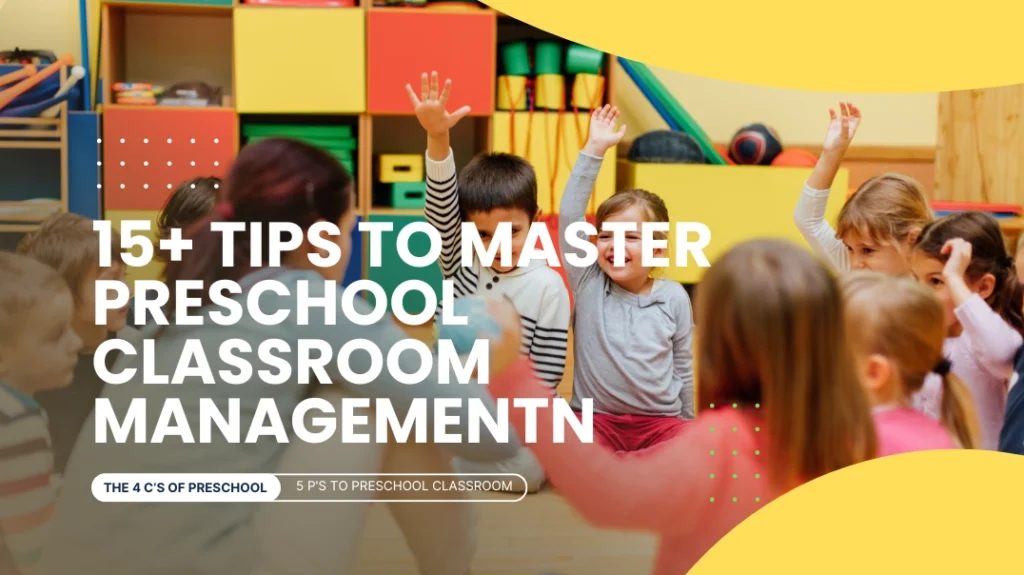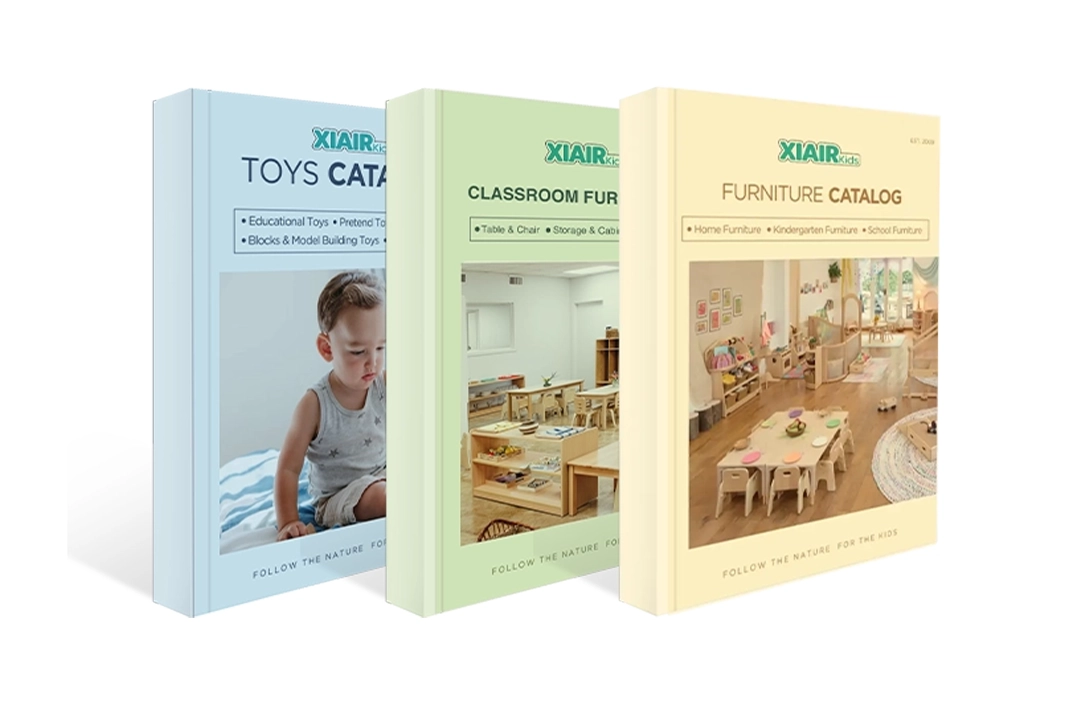Introduction
Classroom management is often one of the most daunting aspects of the job for preschool teachers. From energetic toddlers to young children still learning to socialize, managing a preschool classroom can feel like a constant battle. Without a solid classroom management plan, chaos can quickly take over, leading to disruptive behavior, distracted students, and a less-than-ideal learning environment. Teachers can quickly become overwhelmed, juggling multiple tasks while trying to maintain control and create a nurturing atmosphere for learning.
The stress of managing a preschool classroom doesn’t just impact the children—it also affects the teachers. On any given day, preschool teachers are responsible for guiding students through lessons, monitoring behavior, ensuring safety, and addressing the emotional needs of each child. Keeping things organized and running smoothly can feel impossible with so many responsibilities. It’s easy to feel like no matter how hard you try; you’re constantly battling noise, tantrums, and disengagement, leaving you exhausted and uncertain about how to regain control.
But managing your preschool classroom doesn’t have to be this difficult. Implementing structured yet flexible strategies for the children and the teacher is key. This guide will walk you through practical and effective preschool classroom management techniques that can transform your daily routine. From setting clear expectations and organizing the classroom space to using positive reinforcement and behavioral approaches, these strategies help you regain control, reduce stress, and create a positive, productive learning environment where your students can thrive. No more chaos—just smooth transitions, engaged learners, and a well-managed classroom that benefits you and your students.
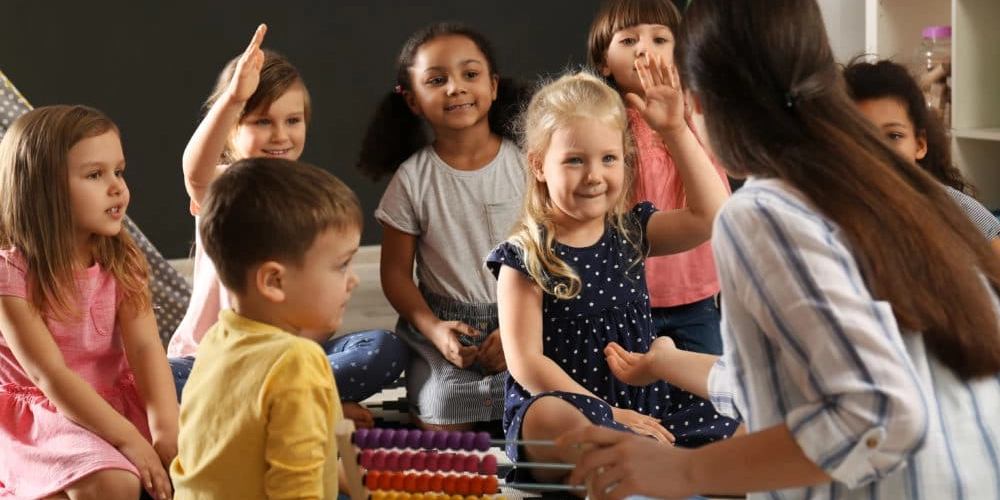
What is Preschool Classroom Management?
Preschool classroom management refers to teachers’ methods and techniques to create a structured, supportive, and positive environment for young children. Children are still developing social and emotional skills at this stage, so it’s crucial to provide clear guidelines for behavior and create a space that encourages learning and interaction. Effective classroom management involves setting rules, creating routines, and organizing the classroom to promote student engagement, focus, and cooperation.
In a well-managed preschool classroom, children understand what is expected of them, know when it’s time to be active and when it’s time to be calm, and are motivated to participate in learning activities. Teachers may use visual cues, simple rules, and consistent routines to ensure children feel secure and can focus on their tasks. Overall, preschool classroom management sets the foundation for a productive, enjoyable learning environment where teaching and learning can thrive.
Why Effective Classroom Management is Crucial for Preschoolers?
Effective classroom management is vital in preschool because it directly influences how children behave, learn, and interact with others. Children learn to follow rules, share with others, and manage their emotions in preschool. A well-managed classroom provides structure and stability, which helps children understand boundaries and develop good habits that support their growth.
When classroom management is effective, students feel safe and supported, which makes them more likely to participate in activities and stay focused. Clear expectations and routines help reduce disruptions, allowing children to explore and learn without constant reminders. Moreover, a positive classroom environment fosters good behavior and cooperation, making it easier for teachers to guide their students through lessons and activities.
Classroom management is also essential for teachers to maintain control over the classroom. Without precise management, preschoolers may struggle with focus and behavior, making it challenging to deliver lessons effectively. Ultimately, strong classroom management benefits both the teacher and the students, ensuring that learning is enjoyable and productive for everyone involved.
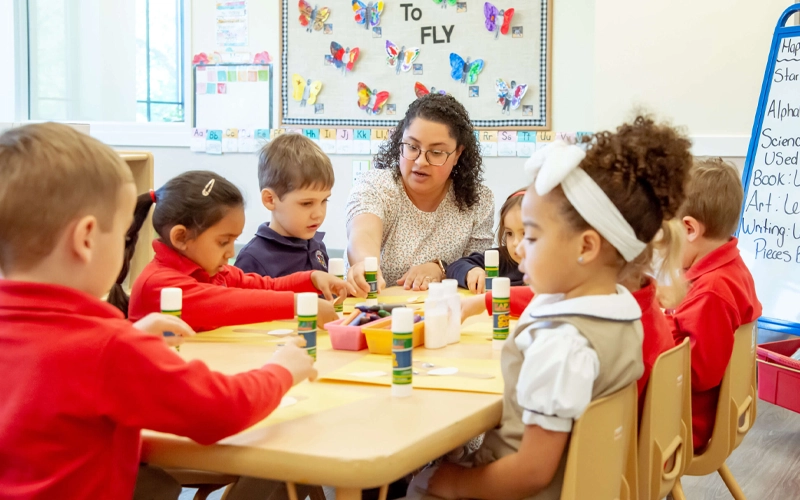

The 5 P’s to Successful Preschool Classroom Management
- Prepared: Be prompt and come to class with the right materials. Be ready to learn and set yourself up for a great learning experience. This means organizing and developing the necessary tools and mindset to engage in class activities.
- Positive: Get yourself into the right attitude before coming to class. Think positively and maintain an optimistic outlook. A positive attitude often leads to better results; expecting a good outcome will help you achieve it.
- Proud: Be proud of the work you’ve done and the effort you’ve put into it. Take time to reflect on your achievements and practice careful work. It’s about taking pride in your effort and the big or small outcomes.
- Polite: Respect your teachers, classmates, and peers. Encourage others to share their thoughts and engage in meaningful conversations. Politeness fosters a supportive and respectful learning environment, making everyone feel valued.
- Patient: Learning takes time, and being patient with yourself is essential. Give yourself grace as you learn new things and practice on your own. Patience is key in learning, allowing you to grow at your own pace.
The 4 C’s of Preschool Classroom Management
- Creativity: Encouraging students to develop innovative and creative thinking. This includes fostering problem-solving skills and engaging in creative projects, arts, and activities that require students to think outside the box.
- Communication: Communication skills are vital in preschool. Children need to learn how to express their thoughts and feelings clearly and understand and interpret others’ verbal and nonverbal communication.
- Collaboration: Collaboration involves working with others to solve problems. In the classroom, it encourages children to work together in groups, share ideas, and coordinate efforts to accomplish tasks, promoting teamwork and social skills.
- Critical Thinking: Fostering the ability to analyze, evaluate, and create solutions to problems. Critical thinking in preschoolers involves encouraging them to ask questions, think deeply, and make thoughtful decisions.
Benefits of Effective Classroom Management in Preschool and Daycare
Effective classroom management is the foundation for creating a positive, engaging, and productive learning environment in preschool and daycare settings. It’s more than just maintaining order—it shapes the entire classroom atmosphere, allowing children to focus, participate, and develop academically and socially. Let’s break down the key benefits of effective classroom management:
- Improved Student Engagement: Students who understand the rules and routines feel secure and more likely to engage in activities. Clear expectations reduce distractions, and children can focus better on the lesson or playtime.
- Reduced Disruptive Behavior: A well-managed classroom minimizes disruptions. Consistent rules, routines, and positive reinforcement teach children appropriate behaviors, creating a more peaceful and controlled classroom environment.
- Fosters Emotional and Social Development: Effective management promotes positive social interactions. With clear boundaries and expectations, children learn to cooperate, share, and understand emotions. This contributes to their overall social and emotional growth.
- Creates a Positive Learning Environment: A structured classroom allows for a calm, predictable environment where children can thrive. Teachers can devote more time to teaching than managing misbehavior, and students are more likely to be motivated and excited about learning.
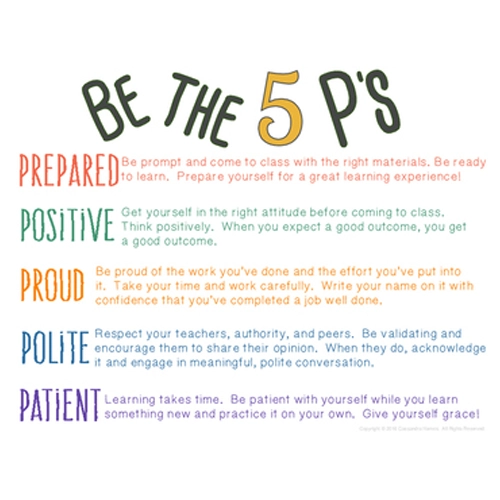
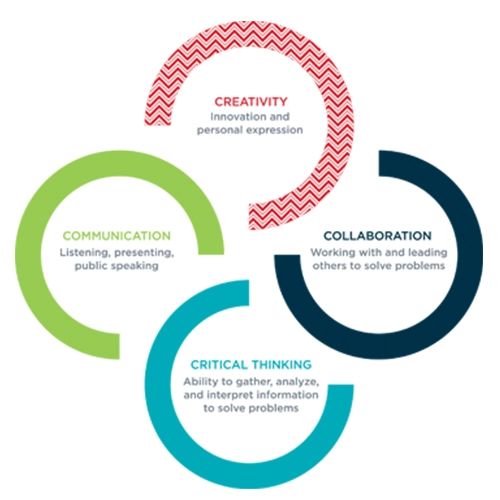
How to Manage Your Preschool and Daycare Classroom
Designing the Perfect Preschool Classroom Layout
A well-organized classroom layout is essential for maximizing learning and minimizing distractions. To design the perfect preschool classroom, consider the following points:
- Create defined learning zones: Designate areas for different activities, such as reading, arts and crafts, and group play.
- Keep space open for movement: Ensure there is room for children to move freely, which is essential for their physical development.
- Use flexible furniture: Incorporate movable tables and chairs to adapt the space for various group sizes and activities.
- Ensure safety: Arrange furniture and materials to reduce hazards and create a safe environment for children to explore.
Considering these aspects, you can create a classroom layout that encourages focus, engagement, and comfort.
Setting Up an Organized Classroom for Preschoolers
An organized classroom helps children stay focused and reduces distractions. Here’s how to keep your classroom organized:
- Label everything: Use pictures and words to label shelves, bins, and materials, helping children find what they need independently.
- Keep learning materials easily accessible: Organize books, toys, and supplies in clearly defined areas that children can access easily.
- Maintain a clutter-free environment: Regularly clean and reorganize the space to avoid unnecessary distractions.
- Involve children in tidying up: Encourage children to put away their materials by making cleanup a routine.
A well-organized classroom creates an environment where children can focus, learn, and engage without unnecessary disruptions.
Your perfect classroom is one click away!
Creating Clear Behavioral Expectations for Preschool Students
Setting clear expectations is key to maintaining a positive classroom environment. To create practical behavioral expectations:
- Use visual cues: Display simple rules with pictures or words that children can easily understand.
- Model desired behavior: Demonstrate the behavior you want to see, such as raising hands to speak or sitting quietly during group time.
- Keep rules simple: Limit the number of regulations to 3-5 main expectations, such as “Listen when others are speaking” or “Use kind words.”
- Reinforce expectations consistently: Praise children when they follow the rules and gently remind them when they forget.
With clear, consistent expectations, children can understand what is expected and will feel more confident following the rules.
Building Consistent Routines for Preschool Children
Consistency is key to helping preschoolers feel secure and focused. Consider the following tips for building effective routines:
- Set a regular daily schedule: Children thrive on predictability. Set times for circle time, snack time, and other activities.
- Use visual schedules: Display a daily schedule with pictures that children can follow to anticipate what comes next.
- Create transition routines: Use songs, cues, or a countdown to signal when it’s time to switch activities, helping children adjust smoothly.
- Involve children in routines: To make them feel involved, assign children roles or responsibilities, like being a line leader or helping with cleanup.
A consistent routine helps children understand what to expect and feel comfortable throughout the day.
Managing Transitions Smoothly with Preschoolers
Transitions between activities can be challenging, but with the right strategies, you can manage them smoothly:
- Give advance notice: Let children know when a transition is coming up by saying, “In five minutes, we’ll clean up and go to the art table.”
- Use a timer or signal: Visual timers or a musical cue can help children understand how much time they have before moving on to the next activity.
- Provide extra time for children who need it: Some children may need more time to finish an activity or transition smoothly—be flexible when necessary.
- Make transitions part of the routine: Make transition times predictable and as calm as possible to reduce anxiety.
Effective transitions help maintain focus and minimize disruptions, making the classroom flow smoothly from one activity to the next.
Incorporating Children’s Feedback into the Classroom Setup
Involving children in the organization and decision-making process fosters a sense of responsibility and ownership. Here’s how to get children’s feedback:
- Ask for input on classroom setup: Let children choose where to work, play, or sit.
- Incorporate their preferences: If children enjoy certain activities or areas, incorporate them more often into the daily routine.
- Encourage choice and autonomy: Give children choices in activities, such as picking a book to read or deciding which art materials to use.
- Validate their ideas: Acknowledge children’s input by using it in the classroom design, which helps them feel heard and respected.
When children are involved in decisions about their learning environment, they become more engaged and invested in their classroom.
Using Positive Reinforcement and Rewards in Preschool Classrooms
Positive reinforcement is a powerful tool to encourage good behavior. Here’s how to use it effectively:
- Offer immediate praise: Recognize and reward positive behavior as soon as it happens, such as saying, “Great job using kind words with your friend!”
- Use tangible rewards: Stickers, tokens, or extra playtime can motivate children to engage in desired behaviors.
- Ensure consistency: Reinforce positive behavior throughout the day so children understand which actions are rewarded.
- Use praise for effort, not just outcomes: Acknowledge effort, such as “You worked hard on that puzzle,” to encourage a growth mindset.
Positive reinforcement builds a classroom culture where good behavior is consistently encouraged and celebrated.
Fun Breaks and Movement Activities in the Preschool Classroom
Preschoolers need regular movement to stay focused and energetic. Here are ways to incorporate fun breaks:
- Schedule movement breaks: Plan short physical activities like dancing, stretching, or jumping to give children a chance to release energy.
- Use the space creatively: Rearrange furniture for fun group activities or interactive games encouraging movement.
- Incorporate games: Simple games like “Simon Says” or “Freeze Dance” can be great for engaging children while allowing them to move.
- Encourage self-regulation: Teach children how to recognize when they need a break and encourage them to take a moment to regroup.
Movement activities help children focus better and promote physical health and social cooperation.
Creating Calm-Down Zones for Emotional Regulation
Having a calm-down zone in the classroom can help children regulate their emotions. To create this space:
- Designate a quiet area: Set up a corner with soft pillows or bean bags where children can retreat when they feel overwhelmed.
- Provide sensory tools: Items like stress balls, coloring sheets, or soft music can help children calm down.
- Teach self-regulation techniques: Show children how to use breathing exercises or quiet time to manage their emotions.
- Respect privacy: Allow children to use the calm-down zone when needed, and make it a safe, inviting space.
A calm-down zone gives children the tools to manage their emotions and return to activities centered.

Making Preschool Classroom Management Easier
Effective Preschool Classroom Management doesn’t have to be overwhelming. With the right tools, strategies, and approaches, classroom management can become more streamlined and enjoyable. Here are several ways to make Preschool Classroom Management easier and more efficient:
Using Classroom Management Apps and Tools for Preschool Teachers
Leveraging Preschool Classroom Management apps and tools can significantly ease your workload. These tools allow teachers to track behaviors, create schedules, and maintain an organized classroom environment. Apps can help with:
- Tracking behavior: Easily monitor students’ behavior and identify patterns that need attention.
- Scheduling: Set up daily routines and activities to create a predictable classroom environment.
- Communication: Share real-time updates with parents about their child’s behavior or classroom activities.
Integrating Preschool Classroom Management tools ensures a smoother, more organized experience for you and your students.
Creating a Positive Preschool Classroom Culture
A positive Preschool Classroom Management culture is essential for creating a productive learning environment. Children are likelier to engage and follow the rules when the classroom atmosphere is welcoming and supportive. Here’s how you can promote a positive classroom culture:
- Encourage positive interactions: Praise good behavior and foster a supportive community where children help each other.
- Set clear expectations: With clearly defined rules, children understand what is expected of them, reducing confusion and enhancing behavior.
- Model respectful behavior: As a teacher, modeling kindness, respect, and empathy helps establish a positive environment.
By focusing on Preschool Classroom Management, teachers can cultivate a culture of respect, cooperation, and growth that supports each child’s development.
Setting Up Effective Classroom Consequences for Misbehavior
When misbehavior arises in the preschool classroom, it’s essential to have a system of consequences that is both fair and effective. Proper Preschool Classroom Management requires setting clear, consistent consequences for misbehavior. Here’s how to implement an effective system:
- Use time-out spaces: Designate specific areas for children to calm down and reflect on their behavior.
- Use verbal reminders: Gently remind children of the classroom rules and expectations.
- Offer praise for improvement: Reinforce positive behavior after correcting a child’s actions.
Setting clear consequences helps children understand the connection between their actions and the outcomes, supporting their emotional growth while maintaining Preschool Classroom Management.
Discipline vs. Punishment: Using Discipline Strategies in Preschool
It’s important to differentiate between discipline and punishment in Preschool Classroom Management. Discipline focuses on teaching children about acceptable behaviors, while punishment may only discourage them temporarily. To foster a positive learning environment, discipline strategies should focus on the following:
- Teach appropriate behavior: Rather than simply reacting to misbehavior, teach children the expected behavior through modeling and practice.
- Redirect behavior: Gently guide children toward appropriate actions, helping them understand the correct response in different situations.
- Use consequences consistently: Be consistent with rules and consequences, ensuring fairness and predictability in the classroom.
By using discipline strategies, Preschool Classroom Management helps children learn from their mistakes and develop good habits.
Promoting Empathy and Emotional Intelligence in Preschoolers
A key component of effective Preschool Classroom Management is helping children develop emotional intelligence. Children are better equipped to interact positively with others when taught how to recognize and manage their emotions. To promote emotional intelligence in preschoolers:
- Teach empathy: Encourage children to recognize the feelings of others and respond with kindness.
- Model emotional regulation: Show children how to calm themselves when upset and provide them with tools to manage their emotions.
- Create a safe space for emotions: Ensure children feel comfortable expressing their feelings without fear of judgment.
By promoting empathy and emotional intelligence, Preschool Classroom Management becomes more than just behavior control—it’s about fostering social-emotional skills to serve children throughout their lives.
Communicating Effectively with Parents about Classroom Management
Strong communication with parents is crucial for successful Preschool Classroom Management. When teachers and parents work together, children benefit from a consistent approach to behavior expectations at home and in the classroom. Here’s how to improve communication:
- Set up regular updates: Keep parents informed about their child’s progress, behavior, and classroom experiences.
- Discuss behavior strategies: Share the methods you use in the classroom to encourage good behavior and invite parents to use similar techniques at home.
- Encourage collaboration: If a child struggles with behavior or social skills, work with parents to develop solutions.
Effective communication with parents supports the efforts of Preschool Classroom Management, ensuring consistency and reinforcement of positive behavior across all environments.


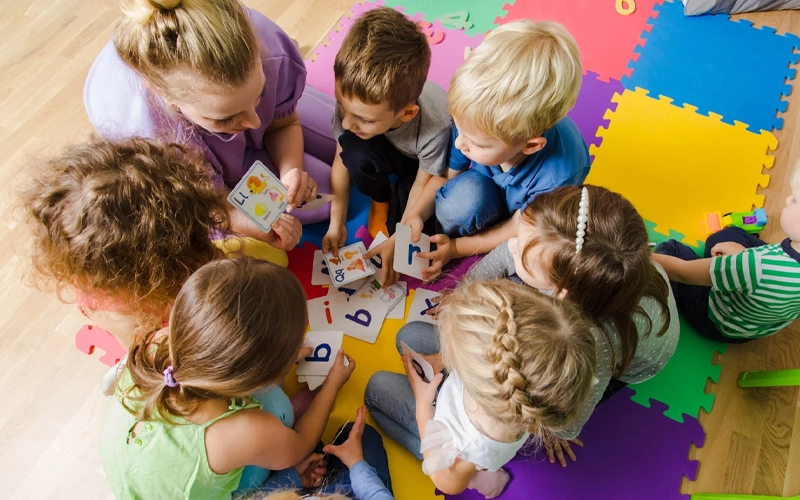
Top Tips for Streamlined Preschool Classroom Management
Utilizing Classroom Management Training and Resources for Teachers
One of the best steps is to leverage available classroom management training and resources to simplify Preschool Classroom Management. Teachers can utilize a variety of professional development opportunities to enhance their skills. Here’s how:
- Online courses and workshops: Many platforms offer courses on effective Preschool Classroom Management, teaching everything from behavior strategies to organizing a learning environment.
- Workshops and seminars: Participating in local or online workshops can give teachers practical tools to implement in their classrooms.
- Peer support and mentorship: Connecting with other teachers for advice or mentorship can provide new insights and strategies for classroom management.
These resources allow teachers to continuously improve their Preschool Classroom Management skills and stay updated with the latest techniques and tools.
Building a Flexible Preschool Classroom Management Plan for the Year
A Preschool Classroom Management plan that adapts to changing classroom dynamics is crucial for maintaining an effective learning environment. To build a flexible plan:
- Set clear goals: Outline behavioral goals and expectations for the year (e.g., promoting social skills and reducing disruptions).
- Monitor progress regularly: Track how well students adapt to routines and rules and adjust strategies as needed.
- Be prepared for changes: Flexibility is key to adapting the plan as student needs evolve or classroom dynamics shift throughout the year.
This flexibility ensures that Preschool Classroom Management remains effective, even as student behavior and needs change.
Preventing Teacher Burnout with an Organized Classroom
An organized classroom is one of the best ways to reduce teacher burnout and enhance Preschool Classroom Management. A well-structured environment not only improves student focus but also reduces the workload for the teacher. Here are ways to maintain organization:
- Create labeled spaces for supplies and student materials, ensuring easy access and reducing time spent looking for things.
- Set a consistent routine: Having a predictable schedule for both students and teachers helps reduce chaos and stress.
- Delegate tasks to students: To reduce the teacher’s burden, give children age-appropriate tasks, like helping to clean up or setting up activities.
An organized classroom makes it easier for teachers to manage their responsibilities, lowering stress and preventing burnout.
Creating a Long-Term Strategy to Manage the Evolving Needs of Students
Preschool Classroom Management requires long-term planning to meet the changing needs of students. This approach ensures that teachers are proactive rather than reactive to classroom dynamics. Here’s how to create such a strategy:
- Track student progress: Regularly evaluate how children adapt to rules and routines and adjust the approach as needed.
- Revisit your management strategies: Update the Preschool Classroom Management plan based on student needs, ensuring strategies are still effective.
- Collaborate with colleagues: Share strategies with other teachers to discover new ways to manage classroom behavior and adapt to changes.
By taking a long-term approach, teachers can anticipate challenges and ensure their Preschool Classroom Management strategies remain effective throughout the year.
Quick Summary of Best Practices and Actionable Strategies for Mastering Preschool Classroom Management
Here’s a quick summary of actionable strategies that teachers can implement for effective Preschool Classroom Management:
| Strategy | Action | Benefit |
|---|---|---|
| Clear expectations | Set simple, age-appropriate rules | Helps children understand boundaries and behave well. |
| Consistent routines | Establish a daily schedule and transition times | Reduces confusion and anxiety for both children and teachers. |
| Positive reinforcement | Praise good behavior and use rewards | Encourages children to repeat positive actions. |
| Classroom organization | Keep materials accessible and organized | Minimizes distractions and promotes independence. |
| Behavioral consequences | Set up fair, consistent consequences for misbehavior | Teaches children about accountability and consequences. |
These best practices help create a stable, predictable environment where students and teachers can thrive. By mastering these strategies, teachers can streamline Preschool Classroom Management and create a more effective learning environment.

Conclusion
Mastering Preschool Classroom Management is key to creating a positive, productive, and engaging environment for young learners. Teachers can significantly improve student behavior, engagement, and learning outcomes by implementing clear expectations, setting consistent routines, and utilizing effective strategies such as positive reinforcement and flexible classroom layouts.
An organized classroom benefits students by providing structure and stability. It also helps teachers reduce stress and prevent burnout, creating a healthier and more sustainable work environment. Throughout this guide, we’ve explored actionable tips and strategies, from building a flexible Preschool Classroom Management plan to creating a positive classroom culture that fosters emotional and social development.
The success of Preschool Classroom Management is built on proactive planning, effective communication with parents, and consistent reinforcement of desired behaviors. By applying these strategies, teachers can create an environment where students and educators thrive—leading to better behavior, stronger social bonds, and enhanced learning experiences.
As you implement these practices, remember that the goal is not perfection but progress. Every day offers an opportunity to improve the classroom dynamics and continue fostering a space that nurtures the growth of young minds. With the right tools, strategies, and mindset, managing a preschool classroom becomes an exciting and rewarding challenge.
